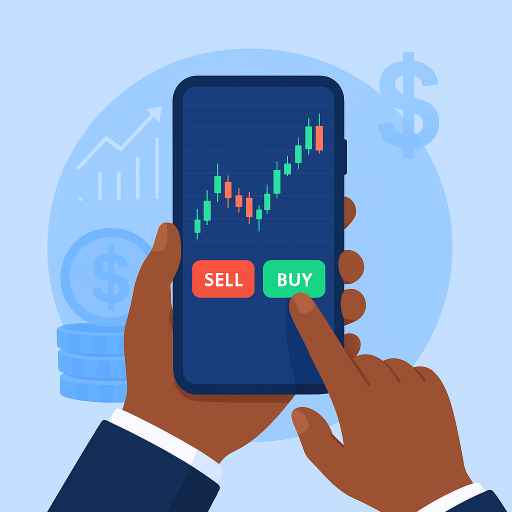
How to buy in forex is one of the first skills every aspiring trader must master. While the forex market might seem overwhelming at first glance, once you understand the step-by-step process of placing and closing a trade, it becomes much easier. In this guide, we’ll walk through the exact steps to place your first buy or sell order on MetaTrader 5 (MT5) and how to close it confidently.
If you don’t understand what forex trading is, refer back to our 👉 simplified introduction to forex trading. Also register with upwardhabits recommended brokers 👉 exness and 👉 fbs. Brokers are where you buy and sell currency. View a broker like any local market in your community, The difference is we buying and selling of currencies instead of typical goods
Step 1: Understanding the Basics Before You Place a Trade
Before we go deeper into how to buy in forex, you need to understand what “buy” and “sell” mean in the forex market. Buying means you believe a currency pair will rise in value, while selling means you expect it to fall. For example, buying EUR/USD means you expect the Euro to strengthen against the US Dollar. This basic concept is the foundation of how to buy in forex successfully.
Step 2: Logging Into MT5
After setting up a broker account (such as Exness or FBS) and linking it to MT5, open the MT5 app and log in using the account details your broker provided. This is your gateway to practicing how to buy in forex in a real or demo environment. Once logged in, you’ll see the “Quotes” tab showing live currency prices.
Step 3: Choosing a Currency Pair
From the “Quotes” section, pick the currency pair you want to trade. Tap on it and choose “New Order.” This is where the core action of how to buy in forex begins. You can trade popular pairs like EUR/USD or GBP/USD, or explore minors and exotics, depending on your strategy and market understanding.
Step 4: Setting Trade Volume
Before you hit “Buy” or “Sell,” set your trade volume (lot size). This determines how large your trade will be. One important tip for beginners learning how to buy in forex is to start with smaller lot sizes to reduce risk. Larger lot sizes mean higher profit potential but also higher losses if the market moves against you.
Step 5: Placing Your Buy or Sell Order
If you believe the price will go up, tap “Buy by Market.” If you think it will go down, tap “Sell by Market.” At this moment, you’ve just taken the most important step in how to buy in forex — executing your first trade. You can now watch your profit or loss change in real time.
Step 6: Setting Stop Loss and Take Profit
A crucial part of how to buy in forex is managing risk. MT5 allows you to set a Stop Loss (SL) to automatically close your trade at a chosen loss level, and a Take Profit (TP) to close it when your target profit is reached. These tools protect your account from large losses and help you stick to your plan.
Step 7: Monitoring Your Open Position
Go to the “Trade” tab to see your active positions. Here, you can monitor how your trade is performing. Anyone learning how to buy in forex must develop patience and avoid making emotional decisions when prices move quickly.
Step 8: Closing a Trade
When you’re ready to exit, go to the “Trade” tab, tap your open position, and choose “Close Position.” The system will instantly lock in your result. Closing is an essential part of how to buy in forex, because knowing when to exit is as important as knowing when to enter.
Step 9: Reviewing Your Trade
After closing your trade, check the “History” tab to review your performance. This reflection step helps you understand what worked and what didn’t, which is critical for improving at how to buy in forex over time.
Final Thoughts on how to buy in Forex
Mastering how to buy in forex is not just about pressing a button — it’s about reading the market, controlling risk, and knowing when to enter and exit. With MT5, you have a powerful platform that makes this process beginner-friendly and efficient. Start small, stay disciplined, and keep practicing. Over time, you’ll gain the confidence to make smarter, more consistent trading decisions.